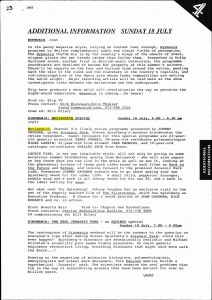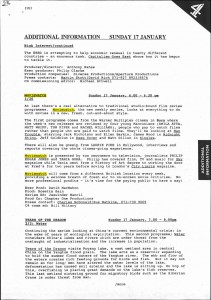Search Databases
Access Records From Our Distinctive Collections
Film Review Shows
Channel 4 Press pack
Search
Browse
What's a Press Pack?
TV Listings
Case Study
The Research Project
Help
Film Review Shows
Moviewatch
Launched in 1993, Moviewatch was a weekly film review show, developed by Channel 4’s commissioning editor for youth, Bill Hilary. The series was initially fronted by a team of young presenters, which included Philip Edgar Jones, Tania Guha and Laurie Pike. Television newcomer Johnny Vaughan joined the team as lead presenter in the second episode, with Guha, Edgar Jones and Pike taking on secondary roles for the remainder of the series. A natural in front of the camera, Vaughan would continue to host the programme until it ended, becoming one of a generation of young stars to receive their big break on Channel 4 in the 1990s.

There could be no suggestion that this was another sycophantic film review programme whose hosts were in the pockets of the distribution sector. Indeed, Vaughan and his co-presenters went out of their way to be irreverent, instigating silly pranks and, on occasion, actively goading directors in order to provoke heated responses from them. For instance, an episode broadcast in February 1996 included a particularly uncomfortable encounter with Martin Scorsese, which was intended to publicise his film Casino (1995). During the course of the interview Vaughan asks Scorsese for details of his favourite pasta recipe, comments on actor Joe Pesci’s diminutive stature and carries out a number of playful stunts. When Scorsese stands up to leave at the end of the interview he admonishes Vaughan, stating that their time together could have been used far more productively. This exchange provides an example of the antics that contributed to Moviewatch’s status as enfant terrible of British film review programming in the ‘90s. Indeed, when being interviewed for the series on one occasion, Sylvester Stallone nervously described it as ‘that cruel show’. 5

Moviewatch was the first Channel 4 series to bring film to a youth audience, occupying an early evening slot that made it far more accessible than Visions’ late-night instalments. Scheduled alongside other popular British teen programmes and American imports, it attracted a substantial audience when contrasted with other series broadcast in the same time slot. Although its relationship with the British regions diminished as each series progressed, it can be argued that the programme did attempt to democratise the process of film reviewing, providing a forum in which ordinary individuals from a range of backgrounds could take part in this typically rarefied activity.
5. Episode broadcast on 25th November 1997.
6. Steve Purcell, ‘McLeod’s Silver Lining: TV Babe Gets her Big Break in Movies’, The Daily Star, 21 February 1997, pp. 22-23; p. 22.
Press Pack Case Studies
These two case studies offer examples of how the press packs informed our research on the AHRC project Channel 4 and British Film Culture.
The Red Triangle
Channel 4’s Red Triangle Experiment of 1986-7 was a response to tabloid press alarms about some late-night adult programme content.